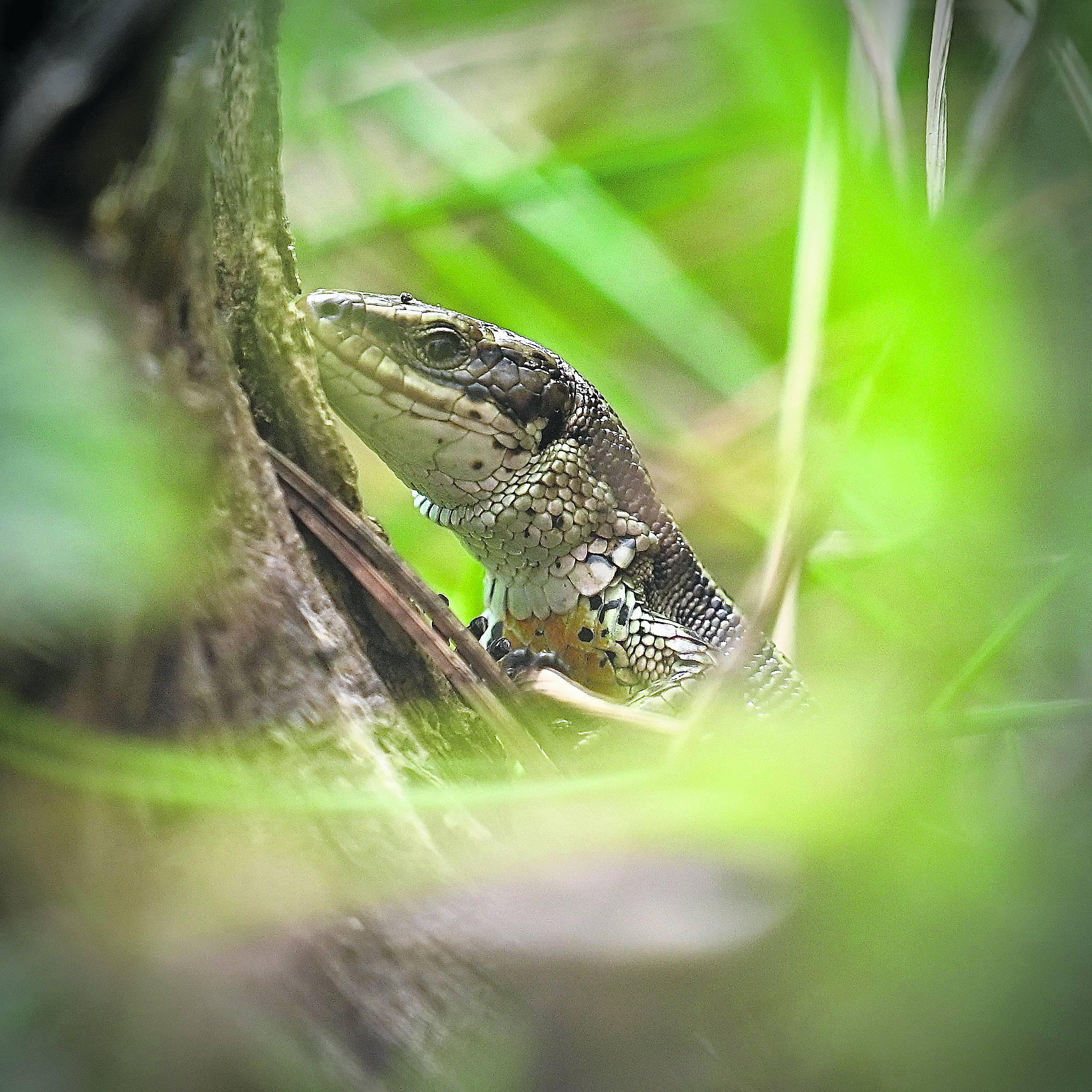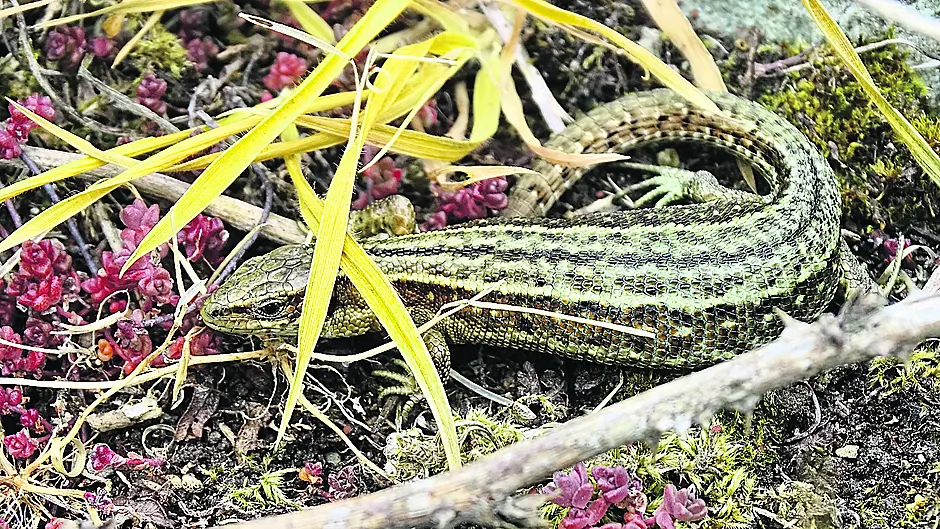IF, like me, you did not make it out of the country for a ‘foreign holiday’ this summer, then feel free to join me in celebrating the common lizard.
Somehow, seeing this lizard brings a sense of the exotic and you can imagine for a moment you are in a different climate altogether. Even if you did get away this summer, it is still a wonder to see these sun-seeking creatures at home.
Where to spot them
I cannot be certain whether our West Cork lizard population is doing particularly well recently, or whether it is because I am seeking them out for that holiday feeling, but we certainly have seen lots of these reptiles this summer.
Most often we have spotted them basking in the sun on dry stone walls along the sides of small roads and fields. Lizards are known to frequent a range of habitats from heath, coastal dunes and grassland to rural gardens and woodland and we have certainly spotted them all along the coast where we have wandered. Seeing lizards at Toe Head, the Mizen, Baltimore, Cape Clear, Ballydehob and elsewhere gives evidence that they are widespread.
 Common lizard seen in Lisheenroe, Castlehaven. (Photo: Nick Haigh)
Common lizard seen in Lisheenroe, Castlehaven. (Photo: Nick Haigh)
Be patient
Common lizards are cold-blooded (ectothermic) meaning that they cannot generate their own body heat, so need to bask in the sun to thermoregulate. Therefore, to spot them, the trick is to keep an eye out for their sun-bathing spots, like logs, stones or bare grassy areas. These intriguing creatures also like to bask close to thick vegetation into which they can quickly retreat for protection from predators if needed. Indeed, you need to approach slowly and carefully to get a good look at them, as they tend to be wary and are very quick to dart for cover. Do not worry if they scurry away, if you are patient they will return, as they usually stick to basking spots once they have chosen them.
Live births
Even though lizards might trigger thoughts of the tropics, they are native here and are our only native land reptile. Known as the common lizard, zootoca vivipara, has a large distribution across Eurasia, from Ireland in the west to Japan in the east and from arctic Russia and Scandinavia in the north to the Mediterranean in the south.
Interestingly, the more northerly populations, such as ours, are adapted to our colder climate. Even though most reptiles lay eggs, in much of its range the common lizard produces eggs but retains them internally to help keep them at a suitable temperature. At the point of giving birth, the egg membranes break and the young lizards emerge alive. Due to this, the common lizard is sometimes called the viviparous lizard, viviparous meaning that they give birth to live young. In warmer climates some populations have been observed laying eggs externally. There is little or no parental care and the newly born lizards are independent from birth. Common lizards become reproductively mature at two to three years and live an average of five years.
The tail trick
Common lizards are carnivores and their diet consists of spiders, slugs, snails, worms and, in particular, insects such as flies and grasshoppers. Lizards, in turn, are a food source for birds of prey, crows and other large birds, stoats, foxes and sometimes even hedgehogs. Sadly, pet cats often kill them too, despite being well-fed at home.
Lizards have a clever trick to try and evade these predators. If they are attacked, threatened or caught by their tail, they can separate from it. Their tail continues to wriggle for a period and provides a distraction while they escape. The tail can slowly regrow and it is common to see lizards with short stumps that are in the process of regrowth. The process is known as autotomy and is not unique to the common lizard. Other animals such as starfish and certain species of crabs, insects and spiders are also capable of losing and regrowing body parts in response to predation attempts.
Seasonal cycles
Lizard hibernation is officially referred to as brumation and usually occurs from March until October. The places that they retreat to for the winter are known as hibernacula. Hibernacula may include underground burrows, cavities amongst tree roots, log piles or rocks. Groups of lizards often hibernate together and European studies show that they can tolerate body temperature levels as low as -3 and -4°C for short periods and survive even when half of their body water has turned to ice for 24 hours.
Studies of the common lizard in Siberia have really highlighted their cold tolerance and demonstrated that they can survive in a frozen state for two months.
In spring, males emerge first to establish a territory, which they defend fiercely. When females arrive, mating is quite a vicious affair, with the male using a bite hold to ensure the female does not escape.
Each female may produce six to 12 offspring, basking in the warmth of the summer sun while pregnant to encourage development of her offspring. The females may give birth any time between July and September, depending on the conditions in any given year. Autumn is a busy time when adults and juveniles alike forage for food to build up their energy reserves before brumation.
 Common lizard seen by the side of the road in Rea, Castlehaven. (Photo: Nick Haigh)
Common lizard seen by the side of the road in Rea, Castlehaven. (Photo: Nick Haigh)
Confusion species
Lizards are sometimes confused with smooth newts, but smooth newts are not reptiles and are one of our three native amphibians. Newts, by comparison, have smoother skin and only have four digits on their front legs while lizards have five. Their behaviour is also different and newts do not bask in the sun, are slower to dart off and require proximity to freshwater to complete their life-cycle. Indeed, a traditional Irish name for the common lizard is earc luachra, which translates as newt or lizard of the rushes, which seems to indicate a lack of distinction between the two species historically.
Slow worms
While I have stated that lizards are Ireland’s only native reptile, they are not our only reptile. We also have the slow worm, which being without legs and growing up to 50cm long has the appearance of a small snake.
The fact they have eyelids, ear holes and a few other differences sets them apart from snakes and makes them a legless lizard. It is thought they were introduced to Ireland from Britain at some point during the 20th century. Most sightings are confined to the Burren, with a few scattered records around the rest of the country.
There is currently no recorded sighting of a slow worm in the National Biodiversity Data Centre database for West Cork, though one was recorded in Tracton in 2020. This strikes me as a great opportunity and challenge to be the first, so keep your eyes peeled! I would certainly love to find a slow worm, but for now I will content myself with visiting our reliable lizard watching spots and imagining I am abroad.






